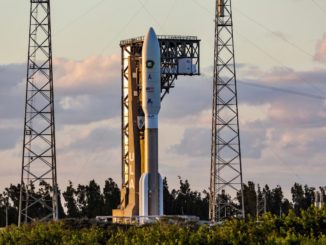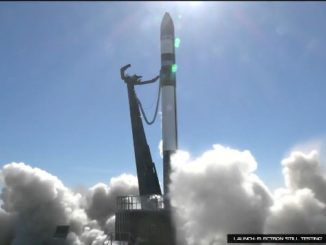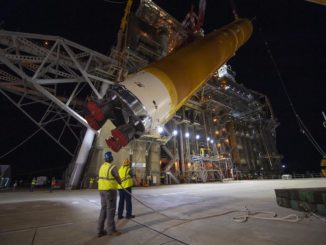EDITOR’S NOTE: Updated at 1445 GMT (10:45 a.m. EDT) Thursday after a successful docking.

A Russian Progress resupply and refueling freighter launched Thursday from the Baikonur Cosmodrome in Kazakhstan on top of a Soyuz booster. The cargo craft completed the fastest rendezvous in the history of the International Space Station program with a successful docking less than three-and-a-half hours later.
The Progress MS-11 supply ship delivered more than 3.7 tons (3.4 metric tons) of propellant, food, hardware, water and breathing air for the space station and its six-person crew, according to a cargo manifest provided by NASA.
Mounted on top of a Soyuz-2.1a rocket, the Progress supply ship lifted off at 1101:35 GMT (7:01:35 a.m. EDT) Thursday from Launch Pad No. 31 at Baikonur. The launch was timed for just 38 seconds before the space station passed over Baikonur, allowing the Progress spacecraft to rapidly catch up to the orbiting complex during two orbits around Earth, arriving within a few hours after separation from the Soyuz third stage.
After its late afternoon blastoff from Baikonur, the Soyuz-2.1a rocket headed northeast on a track aligned with the space station’s orbit. The Soyuz rocket’s four first stage boosters consumed their supply of kerosene and liquid oxygen propellants around two minutes after liftoff, followed by jettison of the launcher’s aerodynamic shroud covering the Progress cargo capsule at about T+plus 3 minutes.
The core stage, also known as the second stage, shut down its four-nozzle engine around five minutes into the mission, giving way to an RD-0110 engine on the third stage to power the Progress cargo craft into a preliminary orbit around Earth. The Progress MS-11 supply ship separated from the Soyuz third stage at T+plus 8 minutes, 45 seconds, and immediately unfurled two power-generating solar array wings and a set of navigation antennas.
At the time of separation from the Soyuz rocket, the Progress cargo craft was located approximately 1,049 miles (1,688 kilometers) behind the space station.

A series of burns to fine-tune the Progress spacecraft’s approach to the space station began at 1141 GMT (7:41 a.m. EDT), and the resupply freighter’s automated rendezvous sequence commenced at 1204 GMT (8:04 a.m. EDT), barely one hour into the mission.
The Progress spacecraft’s Kurs rendezvous radar was activated at 1254 GMT (8:54 a.m. EDT), and the approaching cargo ship moved within a mile (1.6 kilometers) of the space station by 1355 GMT (9:55 a.m. EDT). Flying on autopilot, the cargo carrier lined up with the space station’s Pirs module and began its final approach as the vehicles flew 254 miles (408 kilometers) above Earth.
The cargo vehicle linked up with the Pirs docking compartment at 1422 GMT (10:22 a.m. EDT) — 3 hours and 21 minutes after liftoff — concluding the fastest rendezvous with the International Space Station in its 20-year history.

A Progress resupply mission last July achieved the first two-orbit rendezvous with the station, but the parameters of the flight led to a docking around three hours and 40 minutes after launch. Russian Progress cargo ships and Soyuz crew capsules previously followed six-hour or two-day rendezvous profiles.
Canadian astronaut David Saint-Jacques tweeted a photo of the launch he took from the space station.
Fresh supplies coming our way! This Russian Progress cargo spacecraft just launched from the Baikonur Cosmodrome. It’s also a test-flight for a new streamlined 3-hr launch-to-docking profile. Fingers crossed! #DareToExplore pic.twitter.com/MptMmMqO6y
— David Saint-Jacques (@Astro_DavidS) April 4, 2019
The launch from Baikonur on Thursday was the first of two flights by the Russian Soyuz rocket family in five-and-a-half hours. A separate team is preparing a Soyuz ST-B rocket for liftoff at the Guiana Space Center, the European-run spaceport in South America, with four commercial communications satellites at 1630 GMT (12:30 p.m. EDT).
According to NASA, the Progress supply ship launched Thursday carried 3,375 pounds (1,530 kilograms) of propellant, 3,117 pounds (1,413 kilograms) of dry cargo in the spacecraft’s pressurized compartment, 926 pounds (420 kilograms) of water, and 104 pounds (47 kilograms) of oxygen and air.
The Progress MS-11 cargo mission is the first of three resupply flights taking aim on the space station over the next three weeks.
A Northrop Grumman Cygnus logistics carrier is set for launch on an Antares rocket April 17 from Wallops Island, Virginia, followed by the launch of a SpaceX Dragon cargo capsule April 25 aboard a Falcon 9 rocket April 25 from Cape Canaveral.
Email the author.
Follow Stephen Clark on Twitter: @StephenClark1.



